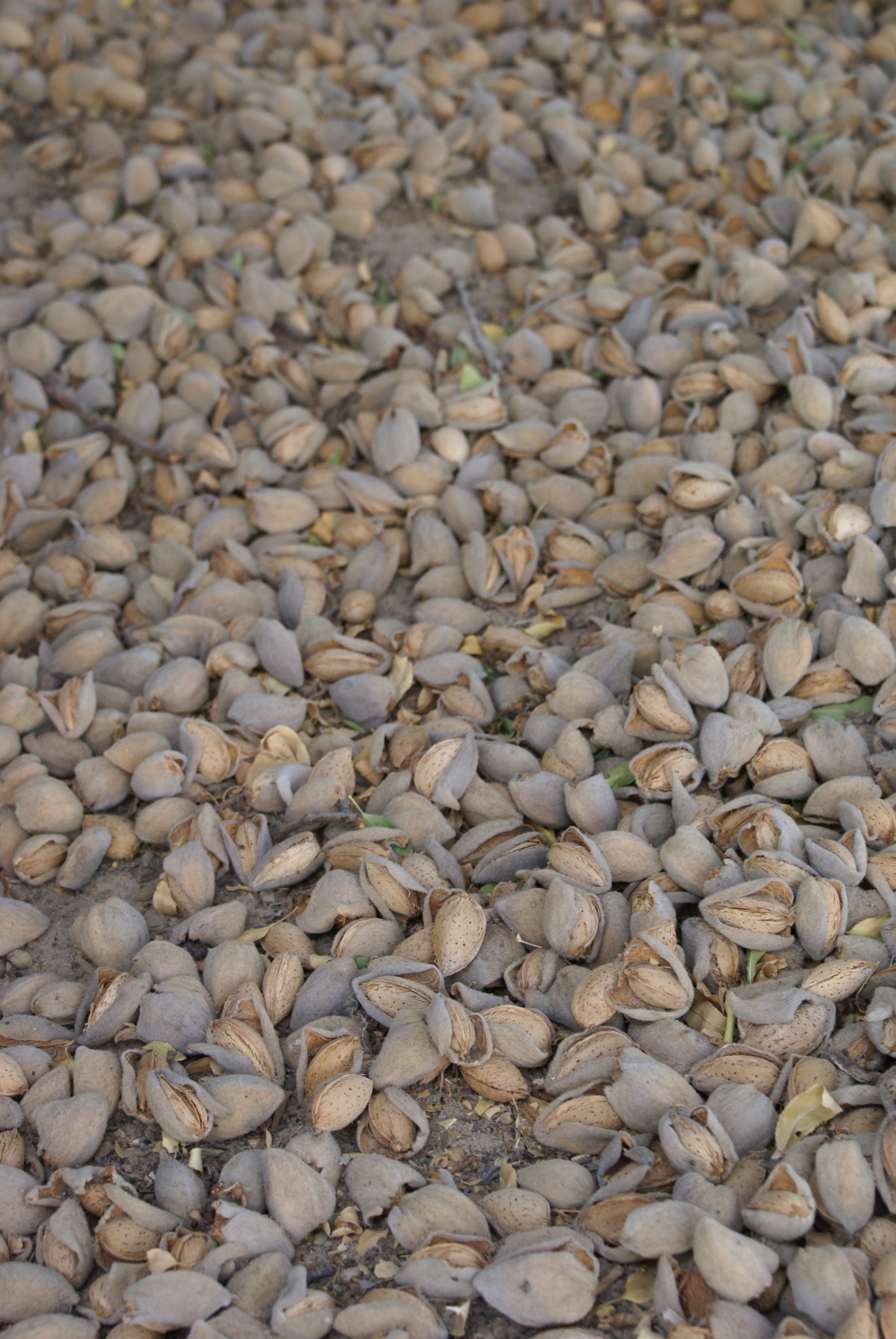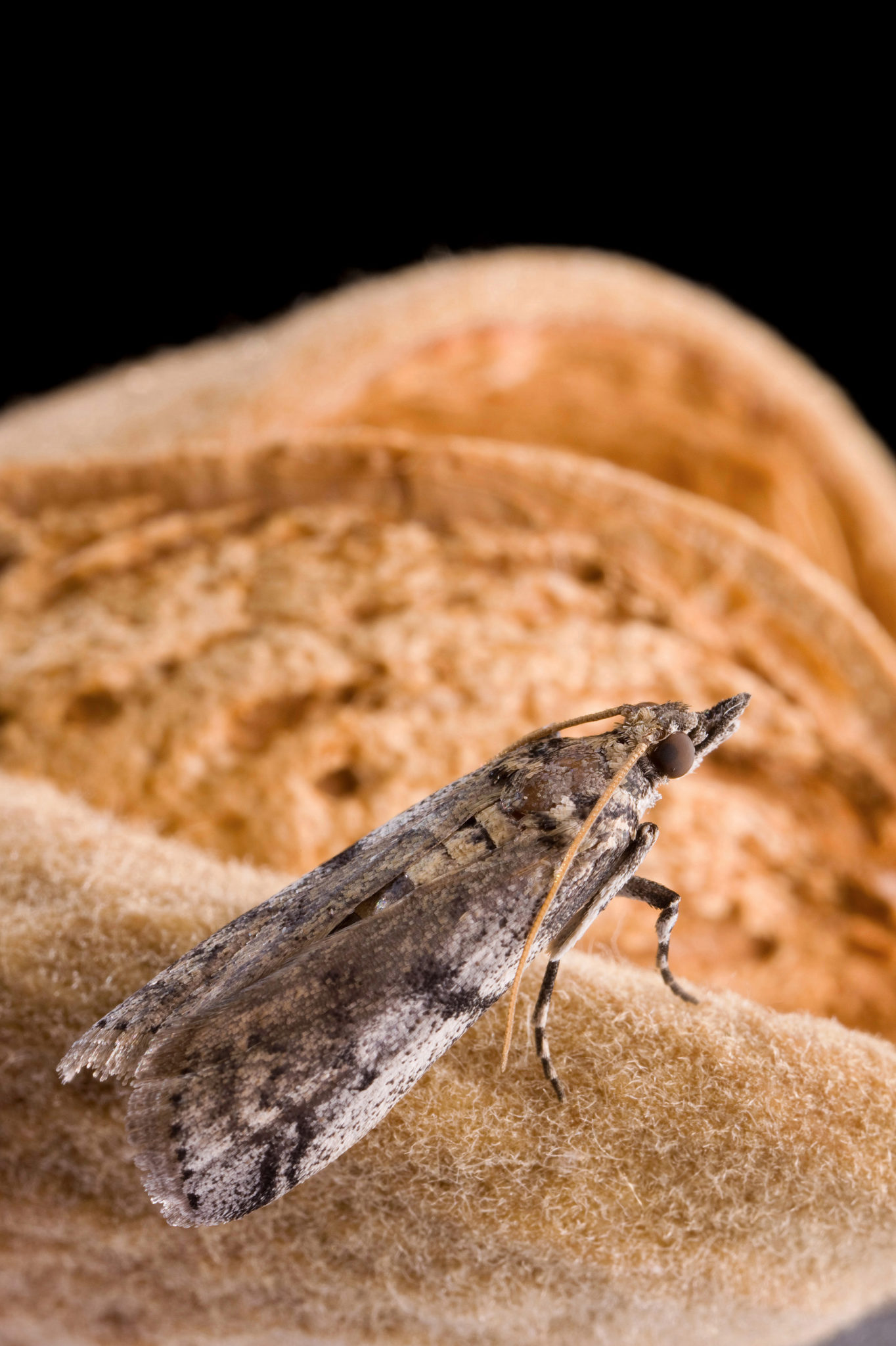
Successful control of navel orangeworm (NOW) depends on understanding the following truths:
-
-
- The local population is always greater than you think it is.
- Insecticide coverage is always worse than the applicator thinks it is.
- Spraying will always take longer than you think that it should.
- Little mistakes can have big consequences.
-
Navel orangeworm management is currently based on a four-component “system”. Its elements are: 1. Sanitation 2. Mating Disruption 3. Insecticide Sprays and 4. Timely Harvest. Three of these elements have been in place for decades, while mating disruption is a relative newcomer. All of these elements are important, and none can be overlooked.
Sanitation is Key
Sanitation is the cornerstone for NOW control in almonds, and all mummies must be removed from the tree, preferably by January. The threshold is 2 mummies per tree outside of Kern County, and for Kern County the threshold can be as low as 0.2 per tree. It is just as important to destroy the mummies on the ground by February as it is to get the mummies off the tree, and all almond varieties can serve as a resource and/or harborage for NOW.
If winter sanitation is inadequate, the overwintering mummy nuts can be treated with an insecticide spray in late April to early May. This will coat the hull so that any eggs laid absorb insecticide and die, plus newly emerged larvae crawling on the nut die from contact toxicity. Insecticides will not kill larvae inside the nut. Treating mummies is important because eggs laid by NOW from mid to late April through early May give rise to the adults in late June to early July, which is the beginning of hull split for the Nonpareil cultivar.
Oviposition during early hull split in the outer rows is often missed by the traditional single spray timing, and when there is substantial hull split in the orchard margins, the NOW population can explode. Use the maximum insecticide rate for mummy sprays because the goal of this spray is to eliminate mummies as a resource from May through June; you want the highest concentration of insecticide possible on mummies. This in turn will decrease the number of moths laying eggs in the orchard margins at the end of June. In previously reported research for Nonpareil almonds, one mummy per tree contributed approximately 1% NOW damage. In the same study, mummies on the ground also contributed to damage when not destroyed by mowing. Mummies on the ground can have infestation rates greater than 75% and adults will emerge from these nuts. Thus, proper sanitation must include both removing mummies from the tree and destroying all mummies on the ground.

Mating Disruption and Insecticides
Currently, there are two interventions available for control of NOW: Mating disruption beginning in late winter and insecticide application at hull split. Mating disruption success depends on excellent sanitation and is not a substitute for sanitation (see related article on mating disruption in this month’s issue of West Coast Nut.) Mating disruption and insecticide application are compatible, and NOW damage can be significantly reduced when they are used together.
When introducing mating disruption, it is important to continue your insecticide program for at least the first year in order to reduce the standing population. In high NOW pressure orchards, multiple insecticide applications may be required. When two sprays are needed, the first application should be applied at 1% hull split in the margins of the orchard, followed by a second application 7-14 days later (depending on the insecticide label.) Pest Control Advisors have reported excellent results when the entire orchard was sprayed, although the pollenizer varieties had not yet split; this is an area of ongoing research.
When spraying, both sides of the tree should be sprayed within a two-day period; do not simply spray every other row (one side of the tree only.) Do not exceed 2 mph with airblast sprayers and use a minimum of 150 gpa for almonds to maximize coverage, especially for tall trees. As ground speed exceeds 2 mph, less spray is deposited in the upper canopy; consequently, failure begins at the top of the tree due to a combination of reduced insecticide deposition combined with increased degradation of the insecticide by ultraviolet radiation.
If it takes more than seven days to complete an application, consider spraying by air for the first spray, since most of the split nuts are high in the canopy. Although a good ground application deposits more insecticide in the canopy than a comparable air application, an aerial application can treat an entire orchard in one day and more insecticide is deposited in the upper canopy, where the newly split nuts are, than in the canopy below 14 feet. Even when two sprays are made to control NOW, there can be delays due to equipment problems, scheduling or unexpected breakdown that interfere with proper spray timing; consequently, application is always a challenge.
Insecticide applications should be applied at 1% hull split. The UC hull split calculator can be used to estimate the timing for 1% hull split (fruitsandnuts.ucdavis.edu), in combination with the data from your indicator trees. The blank almonds usually split 5-7 days before the filled nuts. The hull split model is particularly useful if you use the predicted 1% hull split date to mobilize supplies and equipment ahead of time in order to improve the precision of your timing. Possible insecticide rotations that maximize resistance management are shown in Table 1 (this table is not exhaustive). We recommend using the maximum label rate of insecticide.

Timely Harvest
Timely harvest of the crop removes the nuts from NOW oviposition and infestation. Mummy nut removal, the correct timing of insecticide applications and the use of mating disruption can all be undone by delayed harvest. The harvest should be conducted in accordance with the insecticide label, and when 99% to 100% of the nuts can be removed from the trees by shaking. The nuts will dry on the orchard floor but ideally should not remain on the orchard floor for more than 10 days. It is essential to control ants before harvest or extensive ant damage will occur.















